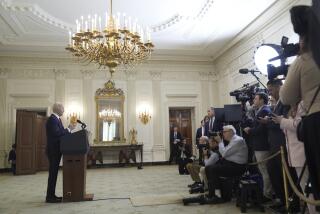Detroit’s Newspapers Fight to Fail : Cynical Maneuver, Blessed by Meese, Should Be Thrown Out
- Share via
At stake today in a courtroom in Washington are the survival of daily newspaper competition in U.S. cities and the success of a ploy worth scores of billions of dollars to the country’s two largest newspaper chains.
U.S. District Judge George Revercomb will be hearing a challenge to the approval by former Atty. Gen. Edwin Meese III of a joint operating agreement (JOA) for the Detroit News and the Detroit Free Press. The papers are owned respectively by Gannett and Knight-Ridder, the No. 1 and No. 2 chains.
Meese approved the pact four days before leaving office. He ruled the Free Press a “failing” paper under the 1970 Newspaper Preservation Act, which seeks to preserve independent news and editorial voices by allowing publishers to merge their business operations if one of the papers otherwise would disappear.
Joint operating agreements already exist in 21 cities. They do much harm, raising advertising and circulation rates to monopoly levels, dampening journalistic competition, hurting suburban and weekly papers and deterring new media start-ups. In approving a joint operating agreement, the government helps some media owners (typically big and powerful ones) at the expense of others, and the resulting fat profits enable the favored owners to buy up still more newspapers and other media outlets.
Whatever one thinks of JOAs in general, Detroit is special. It would be the biggest yet: Both papers are in the nation’s top 10, and the “failing” Free Press is only slightly behind its rival, with a daily circulation of 648,000 to the News’ 688,000. In fact, Gannett and Knight-Ridder negotiated over which paper they would call “failing.” The parity between the papers is also shown by the planned 50-50 profit split.
But the Free Press has been losing a lot of money, and the News almost as much--a combined pretax total of about $100 million since 1980. Why? Because the papers have been waging a ferocious price war. The strategy was plainly designed, on both sides, with an eye on a JOA. A Knight-Ridder five-year plan in 1983 said that the firm’s “objective in Detroit” was an acceptable JOA. Gannett discussed a JOA with Knight-Ridder even before Gannett bought the News in 1986. While keeping prices low, the two firms discussed their “economic window of opportunity--if both papers become marginally profit(able), no JOA.”
On this evidence, the administrative-law judge chosen by Meese to hear the case, Morton Needelman, saw no true “failure.” Both papers were seeking dominance and taking big losses, he said, “in the belief that failure too had its reward.” Take away the joint-operating option and both would have to rethink their strategies, since neither could vanquish the other and the alternative was endless red ink for both.
Having lost on the law before Needelman, Gannett and Knight-Ridder sought non-legal ways to win before Meese. They hired Washington lobbyists, had the Knight-Ridder board vote to close the Free Press if the agreement was not approved, used this threat to scare off opposition in Detroit, and bought off the unions opposing the pact.
Meanwhile, at the Free Press--and at the Miami Herald as well--Knight-Ridder killed editorial cartoons that were critical of Meese.
Sure enough, Meese overruled Needelman--as well as the antitrust division of the Justice Department--and approved the agreement. The Free Press was “failing,” he said, because of its persistent losses that it could not reverse “unilaterally,” and because the News was ahead in the market and was “committed” to continuing its “depressed pricing practices.”
On Aug. 17, hours before the JOA was to go into effect, U.S. District Judge Joyce Hens Green blocked it. Ruling in a suit brought by a group of advertisers, readers and employees, she saw a “substantial likelihood” that in a full hearing Meese’s decision would be found “arbitrary and capricious” and “contrary to law.”
Those are the questions before Judge Revercomb today.
If the Detroit deal is allowed, Meese’s reasoning dooms newspaper competition in most of the 20-plus cities that still have independent competing dailies--cities like New York, Chicago, Los Angeles, Dallas, Houston, Denver, San Antonio, Boston. All but the first three are smaller than Detroit, and in almost all the second paper is comparatively weaker than the Free Press.
To replace competition with monopoly, publishers in these cities need only follow the map drawn in Detroit and blessed by Meese. They need only slash their prices and let the red ink flow. Either the rival paper succumbs, leaving a one-paper monopoly, or the rival fights back, as in Detroit. In that case neither paper can “unilaterally” stop its losses, and the paper that trails is “failing,” according to Meese’s measure. The owners then can sign a JOA, take their losses to the attorney general and cash them in for monopoly profits.
How much profit? The Detroit JOA runs for the modest term of 100 years. Newspaper analyst John Morton, who appeared as an expert supporting the agreement, has estimated that combined annual profits after five years will approach $200 million. This means total profits under the pact ranging upward from $20 billion, probably into the hundreds of billions.
That’s not a bad gift from a Republican attorney general to the nation’s biggest newspaper publishers just as the election campaign gets under way.
More to Read
Sign up for Essential California
The most important California stories and recommendations in your inbox every morning.
You may occasionally receive promotional content from the Los Angeles Times.










